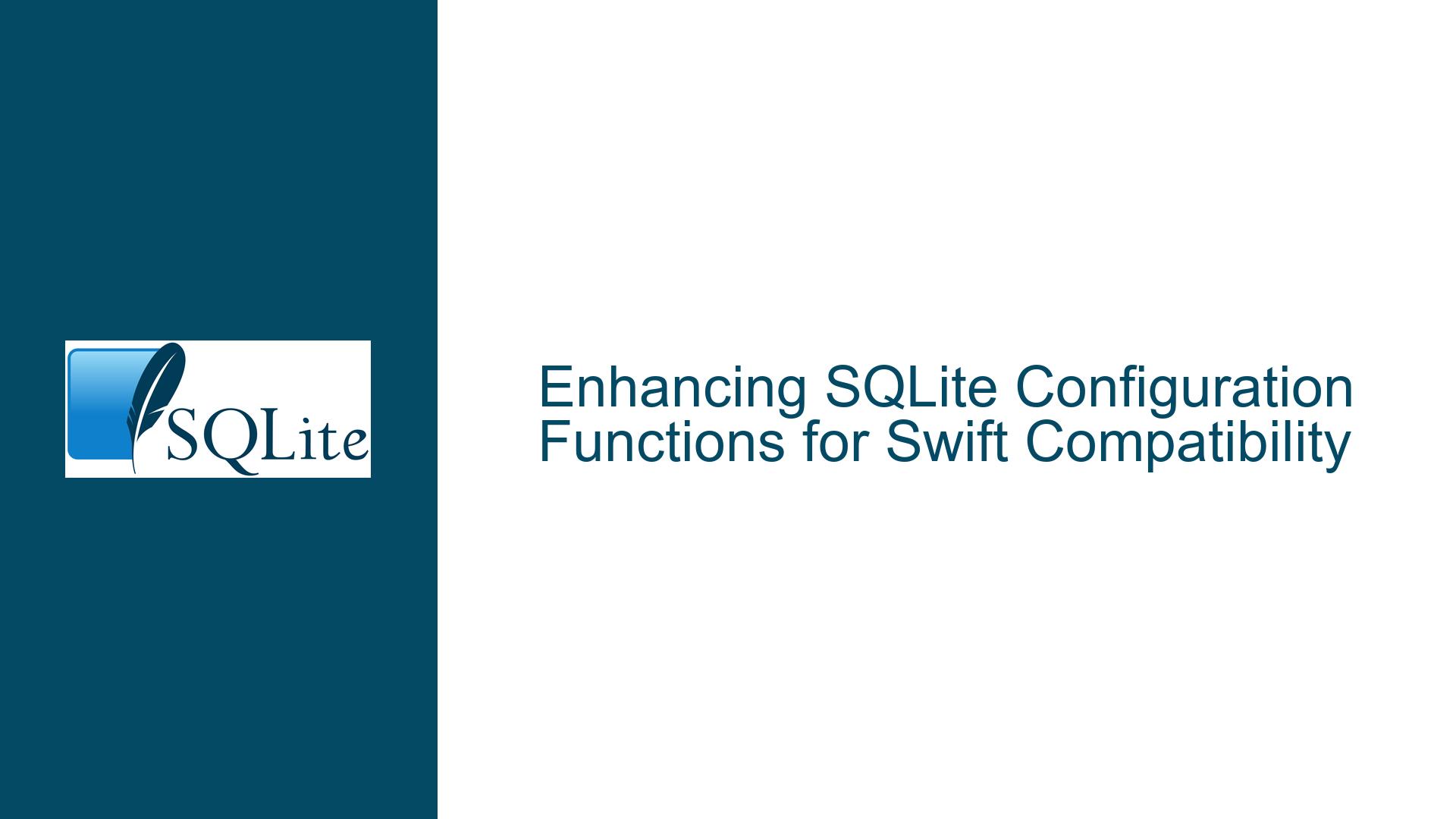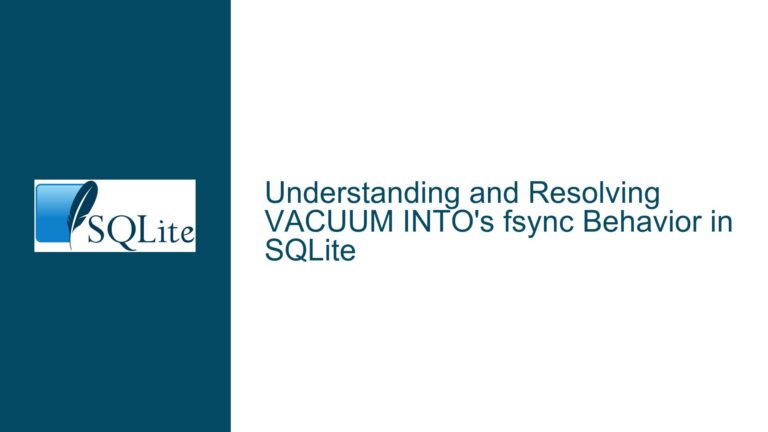Enhancing SQLite Configuration Functions for Swift Compatibility
SQLite Configuration Functions and Swift’s Lack of Variadic Support
SQLite is a widely-used, lightweight, and embedded relational database management system that provides a rich set of APIs for configuration and customization. One of the key functions in SQLite’s API is sqlite3_config, which allows developers to configure global settings for the SQLite library. This function, along with sqlite3_db_config, is implemented as a variadic function in C, meaning it can accept a variable number of arguments. While this is a common pattern in C, it poses challenges for languages like Swift, which do not support calling C variadic functions directly.
Swift, a modern programming language developed by Apple, is designed to work seamlessly with C APIs. However, Swift does not support calling C variadic functions due to safety and type-checking concerns. Instead, Swift provides a type called CVarArg, which is analogous to C’s va_list. This discrepancy creates a barrier for Swift developers who wish to use SQLite’s configuration functions directly.
The core issue revolves around the inability of Swift to call variadic C functions like sqlite3_config and sqlite3_db_config. This limitation forces Swift developers to either write cumbersome bridging code or avoid using these functions altogether, which can hinder the customization and optimization of SQLite in Swift applications. The proposed solution is to introduce vconfig variants of these functions that accept a va_list instead of a variable number of arguments. This approach would allow Swift developers to use SQLite’s configuration functions more naturally by leveraging Swift’s CVarArg type.
Interrupted Write Operations Leading to Index Corruption
The inability to call variadic C functions from Swift is not merely a syntactic inconvenience; it has deeper implications for the robustness and maintainability of Swift applications that rely on SQLite. When developers cannot use sqlite3_config or sqlite3_db_config directly, they may resort to workarounds that can introduce subtle bugs or inefficiencies. For example, a developer might attempt to replicate the functionality of these functions in Swift, leading to code duplication and potential inconsistencies.
Moreover, the lack of direct support for variadic functions can complicate the integration of SQLite with Swift’s memory management and error-handling mechanisms. Swift’s CVarArg type is designed to work with Swift’s type system and memory model, but bridging it to C’s va_list requires careful handling to avoid issues such as memory leaks or undefined behavior. If not done correctly, these issues can manifest as runtime errors or crashes, making debugging and maintenance more challenging.
Another potential cause of problems is the reliance on external libraries or frameworks to bridge the gap between Swift and SQLite’s C API. While these libraries can provide a more Swift-friendly interface, they may not always be up-to-date with the latest SQLite features or may introduce their own bugs and limitations. This can lead to situations where developers are unable to take full advantage of SQLite’s capabilities or are forced to use outdated or suboptimal configurations.
The proposed vconfig variants of sqlite3_config and sqlite3_db_config aim to address these issues by providing a more direct and idiomatic way for Swift developers to interact with SQLite’s configuration functions. By accepting a va_list instead of a variable number of arguments, these variants can be called from Swift using the CVarArg type, eliminating the need for cumbersome bridging code or external libraries.
Implementing vconfig Variants and Ensuring Backward Compatibility
The implementation of vconfig variants for sqlite3_config and sqlite3_db_config involves refactoring the existing code to separate the logic that processes the configuration options from the logic that handles the variadic arguments. This refactoring allows the creation of new functions that accept a va_list and can be called from Swift using the CVarArg type.
The proposed implementation introduces two new functions: sqlite3_vconfig and sqlite3_db_vconfig. These functions are designed to be drop-in replacements for the existing sqlite3_config and sqlite3_db_config functions, with the only difference being that they accept a va_list instead of a variable number of arguments. The existing functions are then modified to call these new functions, ensuring that the behavior remains consistent across both variants.
Here is a detailed breakdown of the changes required to implement the vconfig variants:
Refactoring
sqlite3_config: The existingsqlite3_configfunction is refactored to extract the logic that processes the configuration options into a new function calledsqlite3_vconfig. This new function accepts ava_listand performs the same operations as the original function, but without the need forva_startandva_end. The originalsqlite3_configfunction is then modified to callsqlite3_vconfigwith theva_listobtained from the variadic arguments.Refactoring
sqlite3_db_config: Similarly, thesqlite3_db_configfunction is refactored to extract the logic that processes the configuration options into a new function calledsqlite3_db_vconfig. This new function accepts ava_listand performs the same operations as the original function, but without the need forva_startandva_end. The originalsqlite3_db_configfunction is then modified to callsqlite3_db_vconfigwith theva_listobtained from the variadic arguments.Ensuring Backward Compatibility: One of the key considerations in implementing the
vconfigvariants is ensuring backward compatibility with existing code that uses the originalsqlite3_configandsqlite3_db_configfunctions. By modifying these functions to call the newvconfigvariants, the behavior of the original functions remains unchanged, and existing code continues to work without modification. This approach allows developers to adopt the newvconfigvariants at their own pace, without disrupting existing applications.Testing and Validation: After implementing the
vconfigvariants, it is essential to thoroughly test the changes to ensure that they work as expected and do not introduce any regressions. This testing should include both unit tests and integration tests to verify that the new functions behave correctly and that the existing functions continue to work as before. Additionally, the changes should be tested in a Swift environment to ensure that they can be called from Swift using theCVarArgtype without issues.Documentation and Examples: Finally, it is important to update the SQLite documentation to include information about the new
vconfigvariants and how to use them from Swift. Providing clear and concise examples can help Swift developers understand how to integrate these functions into their applications and take full advantage of SQLite’s configuration capabilities.
By implementing the vconfig variants and ensuring backward compatibility, SQLite can provide a more seamless and idiomatic experience for Swift developers, while maintaining the robustness and reliability that it is known for. This approach not only addresses the immediate issue of Swift’s lack of support for variadic functions but also lays the groundwork for future enhancements and integrations with other languages and platforms.
In conclusion, the introduction of vconfig variants for sqlite3_config and sqlite3_db_config represents a significant improvement in the usability of SQLite in Swift applications. By addressing the challenges posed by Swift’s lack of support for variadic functions, these changes enable Swift developers to leverage SQLite’s powerful configuration capabilities more effectively, leading to more robust and maintainable applications.






